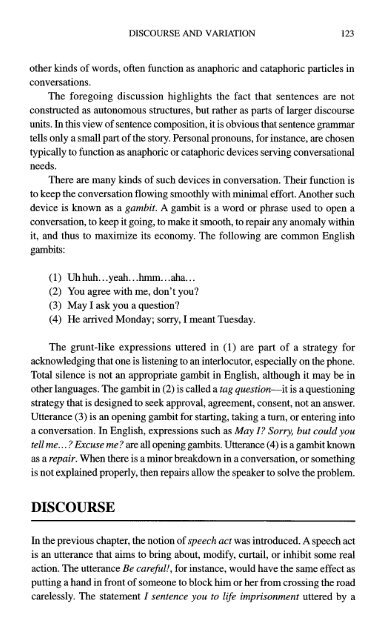A Basic Course in Anthropological Linguistics (Studies in Linguistic ...
A Basic Course in Anthropological Linguistics (Studies in Linguistic ...
A Basic Course in Anthropological Linguistics (Studies in Linguistic ...
You also want an ePaper? Increase the reach of your titles
YUMPU automatically turns print PDFs into web optimized ePapers that Google loves.
DISCOURSE AND VARIATION 123<br />
other k<strong>in</strong>ds of words, often function as anaphoric and cataphoric particles <strong>in</strong><br />
conversations.<br />
The forego<strong>in</strong>g discussion highlights the fact that sentences are not<br />
constructed as autonomous structures, but rather as parts of larger discourse<br />
units. In this view of sentence composition, it is obvious that sentence grammar<br />
tells only a small part of the story. Personal pronouns, for <strong>in</strong>stance, are chosen<br />
typically to function as anaphoric or cataphoric devices serv<strong>in</strong>g conversational<br />
needs.<br />
There are many k<strong>in</strong>ds of such devices <strong>in</strong> conversation. Their function is<br />
to keep the conversation flow<strong>in</strong>g smoothly with m<strong>in</strong>imal effort. Another such<br />
device is known as a gambit. A gambit is a word or phrase used to open a<br />
conversation, to keep it go<strong>in</strong>g, to make it smooth, to repair any anomaly with<strong>in</strong><br />
it, and thus to maximize its economy. The follow<strong>in</strong>g are common English<br />
gambits:<br />
(1) Uhhuh...yeah...hmm...aha...<br />
(2) You agree with me, don’t you?<br />
(3) May I ask you a question?<br />
(4) He arrived Monday; sorry, I meant Tuesday.<br />
The grunt-like expressions uttered <strong>in</strong> (1) are part of a strategy for<br />
acknowledg<strong>in</strong>g that one is listen<strong>in</strong>g to an <strong>in</strong>terlocutor, especially on the phone.<br />
Total silence is not an appropriate gambit <strong>in</strong> English, although it may be <strong>in</strong><br />
other languages. The gambit <strong>in</strong> (2) is called a tag question-it is a question<strong>in</strong>g<br />
strategy that is designed to seek approval, agreement, consent, not an answer.<br />
Utterance (3) is an open<strong>in</strong>g gambit for start<strong>in</strong>g, tak<strong>in</strong>g a turn, or enter<strong>in</strong>g <strong>in</strong>to<br />
a conversation. In English, expressions such as May I? Sorry, but could you<br />
tell me.. . ? Excuse me? are all open<strong>in</strong>g gambits. Utterance (4) is a gambit known<br />
as a repair. When there is a m<strong>in</strong>or breakdown <strong>in</strong> a conversation, or someth<strong>in</strong>g<br />
is not expla<strong>in</strong>ed properly, then repairs allow the speaker to solve the problem.<br />
DISCOURSE<br />
In the previous chapter, the notion of speech act was <strong>in</strong>troduced. A speech act<br />
is an utterance that aims to br<strong>in</strong>g about, modify, curtail, or irhbit some real<br />
action. The utterance Be carejid!, for <strong>in</strong>stance, would have the same effect as<br />
putt<strong>in</strong>g a hand <strong>in</strong> front of someone to block him or her from cross<strong>in</strong>g the road<br />
carelessly. The statement I sentence you to life imprisonment uttered by a






